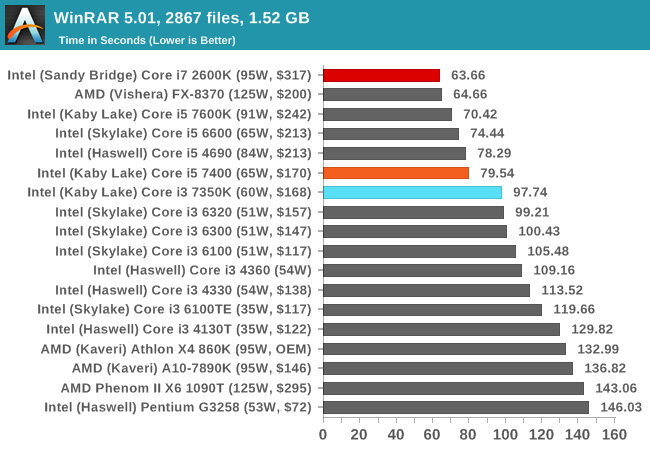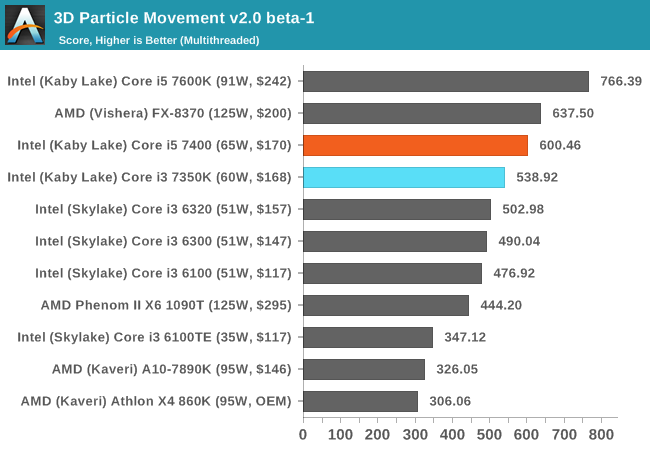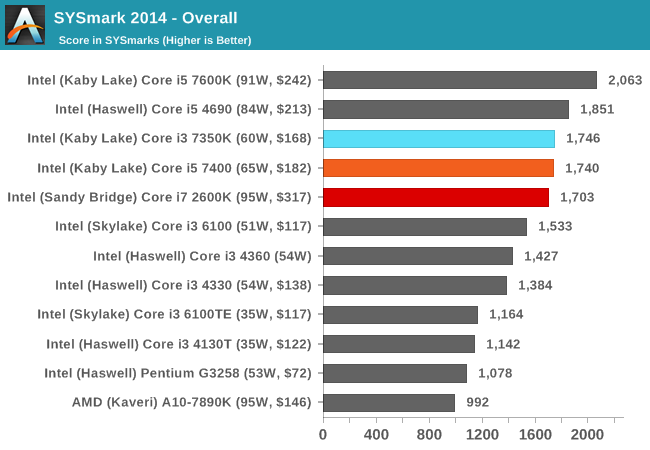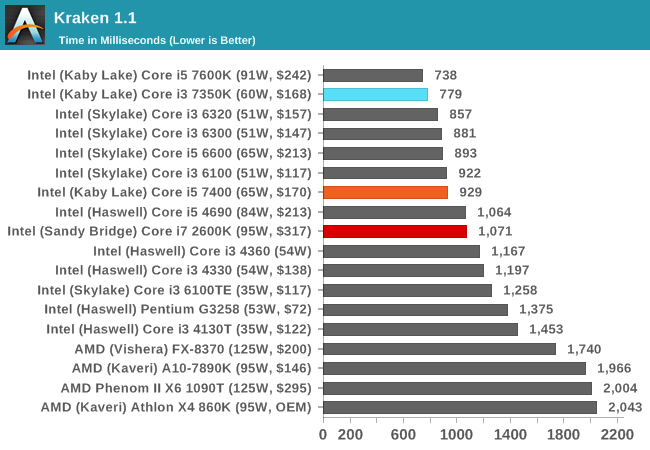The Intel Core i3-7350K (60W) Review: Almost a Core i7-2600K
by Ian Cutress on February 3, 2017 8:00 AM ESTOffice Performance
The dynamics of CPU Turbo modes, both Intel and AMD, can cause concern during environments with a variable threaded workload. There is also an added issue of the motherboard remaining consistent, depending on how the motherboard manufacturer wants to add in their own boosting technologies over the ones that Intel would prefer they used. In order to remain consistent, we implement an OS-level unique high-performance mode on all the CPUs we test which should override any motherboard manufacturer performance mode.
All of our benchmark results can also be found in our benchmark engine, Bench.
Dolphin Benchmark: link
Many emulators are often bound by single thread CPU performance, and general reports tended to suggest that Haswell provided a significant boost to emulator performance. This benchmark runs a Wii program that ray traces a complex 3D scene inside the Dolphin Wii emulator. Performance on this benchmark is a good proxy of the speed of Dolphin CPU emulation, which is an intensive single core task using most aspects of a CPU. Results are given in minutes, where the Wii itself scores 17.53 minutes.

The 7350K, with a high single thread frequency, easily surpasses the i5 and i7-2600K here. That being said, there's a slight difference to the Skylake i3, perhaps down to various generation specific code differences.
WinRAR 5.0.1: link
Our WinRAR test from 2013 is updated to the latest version of WinRAR at the start of 2014. We compress a set of 2867 files across 320 folders totaling 1.52 GB in size – 95% of these files are small typical website files, and the rest (90% of the size) are small 30 second 720p videos.

WinRAR is more geared towards a variable threaded environment but also memory speed. The fact that the Core i5 is above the Core i3 shows that having actual cores helps, regardless of frequency - the additional hyperthreads for the Core i7-2600K also gives it the win, despite the memory frequency difference.
3D Particle Movement v2
3DPM is a self-penned benchmark, taking basic 3D movement algorithms used in Brownian Motion simulations and testing them for speed. High floating point performance, MHz and IPC wins the day. This is the second variant of this benchmark, fixing for false sharing in the first version, and lending itself to better multithreaded performance.

3DPMv2 is still new, so we don’t have too many results for it so far - but again this is another situation where having actual cores helps. This is typically when the threads are 'heavy', i.e. spill out into various caches and require more than 1/2 the cache shared within a core each. In the case of the Kaby Lake, this means that each core has 32KB of L1 - or 32KB per thread for the i5 but only 16KB per thread in the i3.
SYSMark 2014
Engineered by BAPco (to which Intel is a consortium member), this set of tests are designed to be an office/data/media/financial range of tests using common well-known CAD, image editing, web browsing and other tools to put out a score, where a score of 1000 is attributed to an old Core i3 using a mechanical harddrive. Here we report the overall score, however the test breakdowns can be found in Bench.

Because SYSMark is a variety of tests that rely on response and throughput, here is where the Core i3 comes into play over the i5 and i7-2600K. With the i5 it's about equal, but the years of IPC increases put the i7-2600K now behind the Kaby i3.
Web Benchmarks
On the lower end processors, general usability is a big factor of experience, especially as we move into the HTML5 era of web browsing. For our web benchmarks, we take well-known tests with Chrome as installed by SYSMark as a consistent browser.
Mozilla Kraken 1.1

Kraken favors high frequency and IPC, so the i3 takes a large lead over the i7-2600K for this sort of workload.










186 Comments
View All Comments
Michael Bay - Saturday, February 4, 2017 - link
>competition>AMD
Ranger1065 - Sunday, February 5, 2017 - link
You are such a twat.Meteor2 - Sunday, February 5, 2017 - link
Ignore him. Don't feed trolls.jeremynsl - Friday, February 3, 2017 - link
Please consider abandoning the extreme focus on average framerates. It's old-school and doesn't really reflect the performance differences between CPUs anymore. Frame-time variance and minimum framerates are what is needed for these CPU reviews.Danvelopment - Friday, February 3, 2017 - link
Would be a good choice for a new build if the user needs the latest tech, but I upgraded my 2500K to a 3770 for <$100USD.I run an 850 for boot, a 950 for high speed storage on an adapter (thought it was a good idea at the time but it's not noticeable vs the 850) and an RX480.
I don't feel like I'm missing anything.
Barilla - Friday, February 3, 2017 - link
"if we have GPUs at 250-300W, why not CPUs?"I'm very eager to read a full piece discussing this.
fanofanand - Sunday, February 5, 2017 - link
Those CPUs exist but don't make sense for home usage. Have you noticed how hard it is to cool 150 watts? Imagine double that. There are some extremely high powered server chips but what would you do with 32 cores?abufrejoval - Friday, February 3, 2017 - link
I read the part wasn't going to be available until later, did a search to confirm and found two offers: One slightly more expensive had "shipping date unknown", another slightly cheaper read "ready to ship", so that's what I got mid-January, together with a Z170 based board offering DDR3 sockets, because it was to replace an A10-7850K APU based system and I wanted to recycle 32GB of DDR3 RAM.Of course it wouldn't boot, because 3 out of 3 mainboards didn't have KabyLake support in the BIOS. Got myself a Skylake Pentium part to update the BIOS and returned that: Inexcusable hassle that, for me, the dealer and hopefully for the manufacturers which had advertised "Kaby Lake" compatibility for moths, but shipped outdates BIOS versions.
After that this chips runs 4.2GH out of the box and overclocks to 4.5 without playing with voltage. Stays cool and sucks modest Watts (never reaching 50W according to the onboard sensors, which you can't really trust, I gather).
Use case is a 24/7 home-lab server running quite a mix of physical and virtual workloads on Win 2008R2 and VMware workstation, mostly idle but with some serious remote desktop power, Plex video recoding ummp if required and even a game now and then at 1080p.
I want it to rev high on sprints, because I tend to be impatient, but there is a 12/24 core Xeon E5 at 3 GHz and a 4/8 Xeon E3 at 4GHz sitting next to it, when I need heavy lifting and torque: Those beasts are suspended when not in use.
Sure enough, it is noticible snappier than the big Xeon 12 core on desktop things and still much quieter than the Quad, while of course any synthetic multi-core benchmark or server load leaves this chip in the dust.
I run it with an Nvidia GTX 1050ti, which ensures a seamless experience with the Windows 7 generation Sever 2008R2 on all operating systems, including CentOS 7 virtual or physical which is starting to grey a little on the temples, yet adds close to zero power on idle.
At 4.2 GHz the Intel i3-7350K HT dual is about twice as fast as the A10-7850K integer quad at the same clock speed (it typically turbos to 4.2 GHz without any BIOS OC pressure) for all synthetic workloads I could throw at it, which I consider rather sad (been running AMD and Intel side by side for decades).
I overclocked mine easily to 4.8 GHz and even to 5 GHz with about 1.4V and leaving the uncore at 3.8 GHz. It was Prime95 stable, but my simple slow and quiet Noctua NH-L9x65 couldn't keep temperatures at safe levels so I stopped a little early and went back to an easy and cool 4.6 GHz at 1.24V for "production".
I'm most impressed running x265 video recodes on terabytes of video material at 800-1200FPS on this i3-7350K/GTX 1050ti combo, which seems to leave both CPU and GPU oddly bored and able to run desktop and even gaming workloads in parallel with very little heat and noise.
The Xeon monsters with their respective GTX 1070 and GTX 980ti GPUs would that same job actually slower while burning more heat and there video recoding has been such a big sales argument for the big Intel chips.
Actually Handbrake x265 software encodes struggle to reach double digits on 24 threads on the "big" machine: Simply can't beat ASIC power with general purpose compute.
I guess the Pentium HT variants are better value, but so is a 500cc scooter vs. a Turbo-Hayabusa. And here the difference is less than a set of home delivered pizzas for the family, while this chip will last me a couple of years and the pizza is gone in minutes.
Meteor2 - Sunday, February 5, 2017 - link
Interesting that x265 doesn't scale well with cores. The developers claim to be experts in that area!abufrejoval - Sunday, February 12, 2017 - link
Sure the Handbrake x265 code will scale with CPU cores, but the video processing unit (VPU) withing the GTX 10x series provides several orders of magnitude better performance at much lower energy budgets. You'd probably need downright silly numbers of CPU cores (hundreds) with Handbrake to draw even in performance and by then you'd be using several orders of magnitude more energy to get it done.AFAIK the VPU all the same on all (consumer?) Pascal GPUs and not related to GPU cores, so a 1080 or even a Titan-X may not be any faster than a 1050.
When I play around with benchmarks I typically have HWinfo running on a separate monitor and it reports the utilization and power budget from all the distinct function blocks in today's CPUs and GPUs.
Not only does the GTX 1050ti on this system deliver 800-1200FPS when transcoding 1080p material from x264 to x265, but it also leaves CPU and GPU cores rather idle so I actually felt it had relatively little impact on my ability to game or do production work, while it is transcoding at this incredible speed.
Intel CPUs at least since Sandy Bridge have also sported VPUs and I have tried to them similarly for the MPEG to x264 transitions, but there from my experience compression factor, compression quality and speed have fallen short of Handbrake, so I didn't use them. AFAIK x265 encoding support is still missing on Kaby Lake.
It just highlights the "identity" crisis of general purpose compute, where even the beefiest CPUs suck on any specific job compared to a fully optimized hardware solution.
Any specific compute problem shared by a sufficiently high number of users tends to be moved into hardware. That's how GPUs and DSPs came to be and that's how VPUs are now making CPU and GPU based video transcoding obsolete via dedicated function blocks.
And that explains why my smallest system really feels fastest with just 2 cores.
The only type of workload where I can still see a significant benefit for the big Xeon cores are things like a full Linux kernel compile. But if the software eco-system there wasn't as bad as it is, incremental compiles would do the job and any CPU since my first 1MHz 8-Bit Z80 has been able to compile faster than I was able to write code (especially with Turbo Pascal).